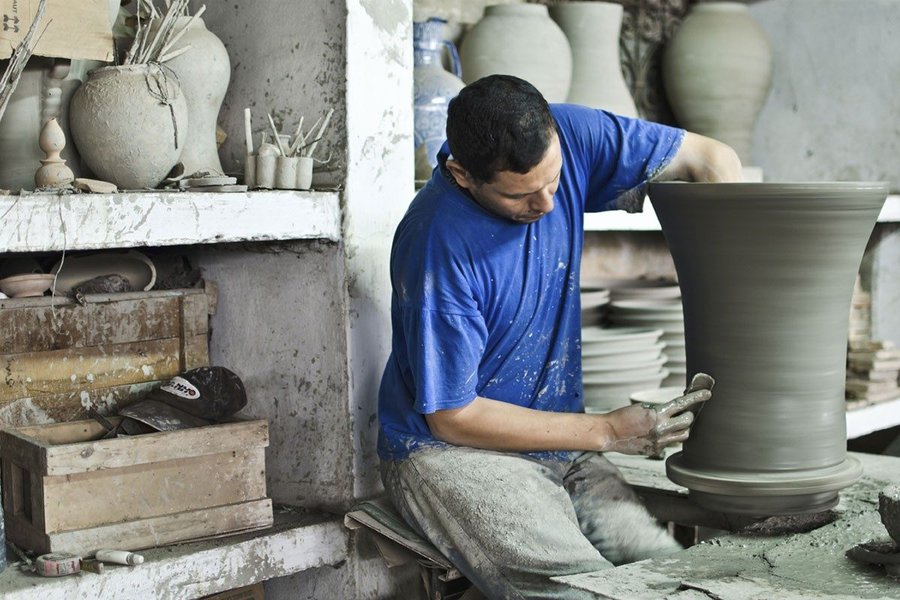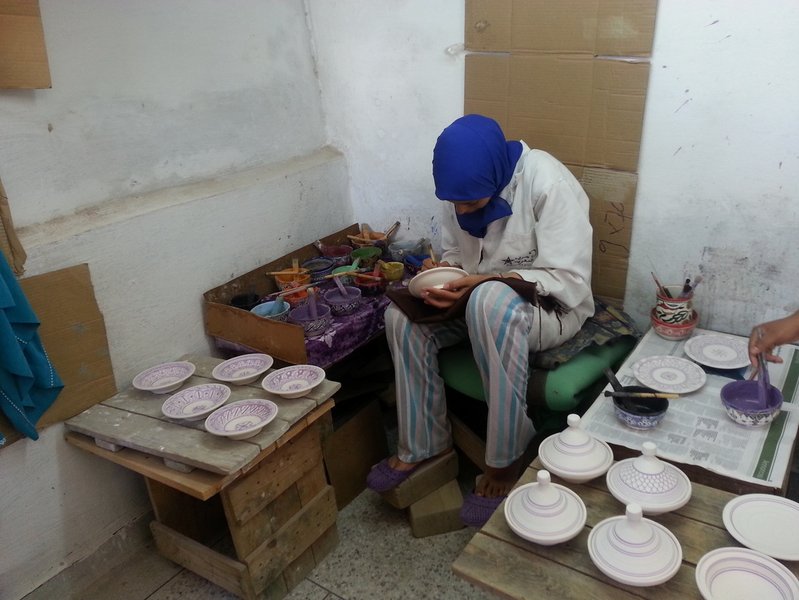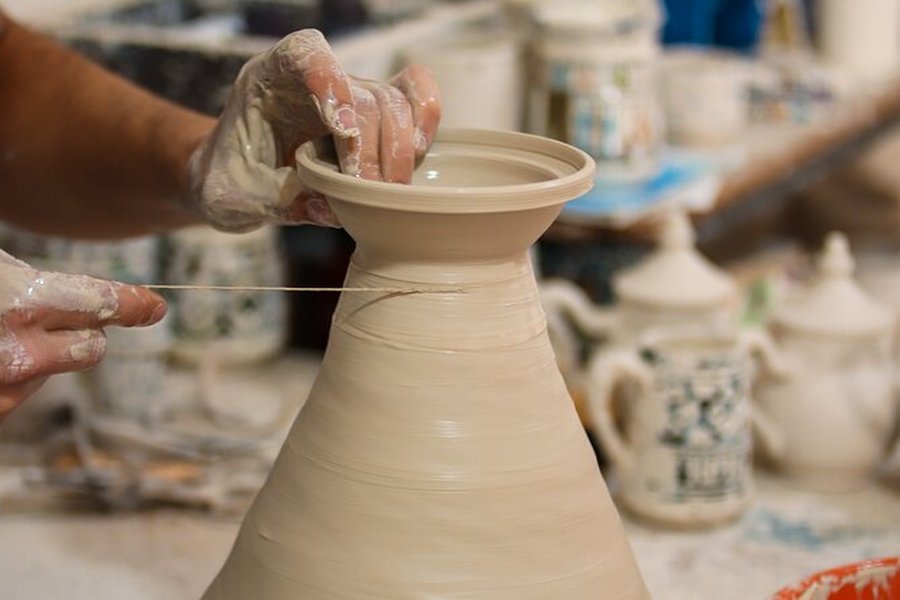History of Moroccan Fassi pottery
Share
Unearthing the Enchanting World of Fassi Pottery: A Deep Dive into Morocco's Ceramic Heritage
Explore the timeless artistry and intricate traditions behind the renowned cobalt blue and white ceramics of Fes.

The Genesis of Fassi Pottery: From Earth to Art
The journey of Fassi pottery begins with the careful selection of raw materials, primarily locally sourced gray clay. This high-quality clay, predominantly found in the Meknes and Sefrou regions, is prized for its fine texture and inherent durability. The initial stages of preparation are labor-intensive, involving the drying of the raw clay, followed by an extensive soaking period in water for approximately a week. This process softens the clay, making it pliable. Subsequently, the clay undergoes a rigorous kneading process, often performed by foot and hand, to eliminate air bubbles and achieve the perfect consistency for shaping.
An artisan meticulously designing a Fassi pottery piece.
Shaping Tradition: The Potter's Wheel
Once the clay is prepared, artisans utilize a traditional, foot-turned pottery wheel to meticulously shape each piece. This ancient method provides the artisan with unparalleled control and precision, allowing for the creation of diverse forms, from elegant bowls and dishes to intricate vases and functional cooking pots. After shaping, the pottery is left to dry naturally under the warmth of the sun, a crucial step that prepares the pieces for the subsequent stages of decoration and firing.
The Signature Palette: Cobalt Blue and Intricate Designs
A defining characteristic of Fassi pottery is its distinctive decoration. After drying, the pieces are often coated with a pristine white glaze, serving as a canvas for the vibrant cobalt blue patterns. The characteristic "Fez blue" is derived from natural cobalt oxide, a pigment that yields a rich, deep hue upon firing. Artisans then meticulously hand-paint intricate geometric designs, often spiraling outwards in captivating circular patterns. These designs are not merely decorative; they carry centuries of cultural symbolism and artistic expression.

A display of finished Fassi pottery, showcasing its iconic blue and white patterns.
The Fiery Transformation: Double Firing for Durability
The final, transformative stage involves a double firing process. This high-temperature firing in traditional kilns, often fueled by ground olive pits, is vital for several reasons. It not only hardens the clay, contributing significantly to the pottery's strength and durability, but also intensifies the vibrant colors of the glazes and pigments. This rigorous firing process makes many Fassi pottery items suitable for modern use, including resistance to microwaves and dishwashers, highlighting a blend of traditional craftsmanship with contemporary functionality.
The Cultural Epicenter: Fes and its Potters' Quarter
Fes is unequivocally recognized as a major center for Moroccan ceramics, with its pottery being highly prized both domestically and internationally. While ceramics are sold throughout Moroccan medinas, establishments specializing in Fassi pottery are distinguished by their superior quality, intricate designs, and the reflection of their craftsmanship in their pricing. The heart of this traditional artistry lies in the Potters' Quarter of Fes, known as Ain Nokbi, situated just outside the medina. This bustling hub is where the timeless techniques and skills continue to thrive, perpetuating a legacy that is very much a family affair, passed down from one generation to the next.

Pottery and mosaic workshops in Fes, showcasing the hands-on traditional methods.
Visualizing Fassi Pottery's Attributes
To better understand the multifaceted aspects of Fassi pottery, let's look at a radar chart and a bar chart illustrating its key attributes based on their perceived strength and importance in the craft.

The radar chart above illustrates various attributes of Fassi pottery on a scale of 0 to 5. "Artistic Complexity" and "Cultural Preservation" score high, reflecting the intricate designs and the deep-rooted generational traditions. "Historical Significance" also ranks at the top, given its centuries-old heritage. "Material Quality" and "Durability" are also strong, highlighting the use of premium local clay and the robust double-firing process.

This bar chart evaluates different aspects of Fassi pottery production on a scale of 0 to 10. "Craftsmanship Skill" and "Firing Precision" are highly rated, underscoring the expert hands and meticulous processes involved. "Material Sourcing" also scores well, reflecting the importance of local clay. "Glaze Application" and "Design Innovation" are also strong, though perhaps with slightly more room for variation given the traditional nature of the art.
A Glimpse into Zellige Craftsmanship: A Complementary Art Form
While direct, dedicated videos specifically on "Moroccan Fassi Pottery" in English are not widely available, there are highly relevant resources that offer a comprehensive look at the closely related ceramic traditions of Fes. One such invaluable resource is an excellent 10-minute documentary showcasing zellige craftsmen in Fes. Zellige tilework, much like Fassi pottery, is an ancient Moroccan art form involving intricate mosaic tilework made from individually chiseled geometric tiles set into a plaster base. The skills and techniques employed in zellige production share deep roots with those found in Fassi pottery, particularly concerning clay preparation, shaping, and the aesthetic principles of geometric design and color application.
This video, "FEZ, MOROCCO, ONE OF THE GREATEST MEDIEVAL...", provides a general overview of Fes, including a brief visit to a ceramic factory. While not solely focused on Fassi pottery, it offers visual context of the environment where these crafts thrive. The segment on the ceramic factory showcases the artisanal atmosphere and some of the traditional processes involved in Moroccan ceramics, which are broadly applicable to Fassi pottery, even if not explicitly detailed. It helps to contextualize the production within the vibrant Medina of Fes, where these ancient crafts are preserved.
The Artistry Unveiled: A Mindmap of Fassi Pottery
To further illustrate the interconnected elements that define Fassi pottery, here is a mindmap outlining its core characteristics, processes, and cultural significance.
This mindmap provides a structured overview of Fassi pottery, detailing its historical context, unique characteristics, the comprehensive production process from clay sourcing to firing, and its profound cultural significance. It also highlights the typical applications of these beautiful ceramic pieces.
Comparative Overview of Moroccan Pottery Centers
While Fes is renowned for its distinctive blue and white Fassi pottery, other Moroccan cities also boast unique ceramic traditions. The table below offers a comparative look at Fassi pottery versus general Moroccan pottery, highlighting key differences and similarities.
| Feature | Fassi Pottery (Fes) | General Moroccan Pottery (e.g., Safi, Tamgrout) |
|---|---|---|
| Primary Colors/Patterns | Distinctive cobalt blue and white, intricate geometric and spiraling designs. | Varies widely; often includes vibrant multi-colors, terracotta tones, green (Tamgrout), and simpler patterns. |
| Clay Source | Gray clay from Meknes and Sefrou regions, known for fine texture and durability. | Local clay sources, varying by region (e.g., red clay in Safi, specific earth in Tamgrout). |
| Traditional Techniques | Foot-turned pottery wheel, double firing, detailed hand-painting. | Mix of foot-turned and electric wheels, single or multiple firings, hand-painting, and glazing techniques vary. |
| Durability | Often highly durable, many pieces are microwave and dishwasher safe due to high-temperature firing. | Varies, some pieces are for decorative use only, others are functional but may not withstand modern appliances. |
| Cultural Influence | Strong Arab, Berber, and Andalusian influences, particularly in geometric motifs. | Blend of regional and broader Moroccan cultural influences. |
| Focal Point of Production | Ain Nokbi (Potters' Quarter) in Fes. | Various artisan quarters and villages throughout Morocco (e.g., Safi for glazed ceramics, Tamgrout for green pottery). |
| Distinguishing Mark | Known for refined craftsmanship and specific "Fez blue" aesthetic. | Recognized for regional variations in form, color, and glazing. |
This table underscores that while there are shared traditional elements across Moroccan pottery, Fassi pottery distinguishes itself through its specific aesthetic, material sourcing, and emphasis on enduring quality, making it a unique and highly sought-after art form.
FAQ about Fassi Pottery
Conclusion
Fassi pottery stands as a vibrant testament to Morocco's rich artistic heritage, particularly in the city of Fes. Its intricate designs, the signature cobalt blue and white aesthetic, and the meticulous, generations-old production techniques combine to create pieces that are not only beautiful but also culturally significant and highly durable. The art form embodies a deep connection to tradition, a reverence for natural materials, and an unwavering commitment to craftsmanship. While finding a dedicated video specifically on "Moroccan Fassi Pottery" in English can be challenging, the broader context of Moroccan ceramic traditions, especially through resources on zellige tilework, provides an excellent understanding of the skills and cultural depth involved. Fassi pottery remains a cherished symbol of Moroccan artistry, a tradition passed down through families, ensuring its legacy continues to flourish for centuries to come.
Recommended Further Exploration
- Explore the traditional techniques employed in Moroccan pottery across different regions.
- Delve into the cultural and historical importance of Zellige tilework and its connection to Moroccan ceramics.
- Discover what a visit to Ain Nokbi, the Potters' Quarter in Fes, entails for a deeper immersive experience.
- Trace the historical evolution of Moroccan ceramic designs and their cultural influences.
